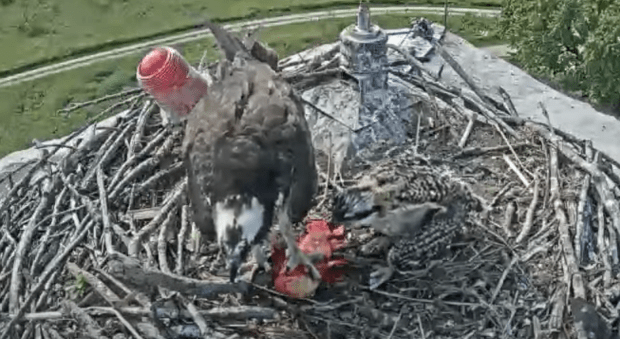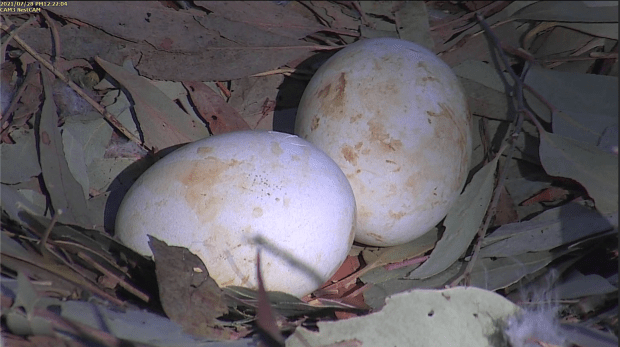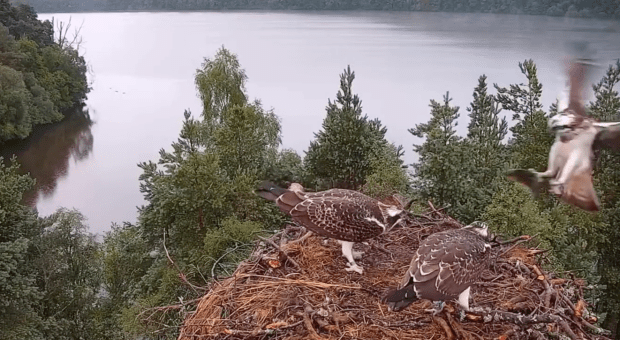Do people who love storks like to send me private notes? Most often, no one will mention in a comment that their favourite bird is actually ‘the stork’. It is curious. My interest in storks is their behaviour, and sometimes their actions can be alarming. This is especially true when the adults decide there is not enough food available for seven storks, only three or four. Of course, the question lingers: why do some storks lay so many eggs that hatch when there is not nearly enough food for even half? The only answer that I have is that they are ‘insurance eggs’ like the second egg in an eagle nest.
For those people who love storks, here is something special. This video clip is of the White Stork nest in Mlade Burky, Czech Republic, this afternoon when two are on the nest in the hope of getting a meal from Father Stork. You might think that this is a ‘contemporary’ stork dance! They are incredibly graceful.

This video clip shows Pantrac, the female, on the nest. She has just flown in. She sees Father Stork arriving in the distance and is food begging.
This is the link to the streaming cam for the White Storks in Mlade Buky:
The storks were given lovely names. Pankrac (CE887) is the female seen in the video clip above with the dad, Bukacek. Servac (CE886) and Bonifac (CE885) were the two males. Sadly, I received a message today that Bonifac has been electrocuted in the same manner as his mother. He was killed on 29 July at approximately 14:08. It was not the same pole.
Is there a silver lining? My reader ‘S’ believes so. There are two healthy storks alive thanks to Sandor Havran and Jin Zeman, who organized feeding the little ones and then feeding Bukacek separately to not frighten the growing storks. Bukacek often fed his little ones ten times a day. That is incredible. The issue of electrocutions is not limited to Czechoslovakia. It has happened in my province also.
My reader, ‘S’, informs me that a law was passed to place protections for the birds on the electric transmission lines in 2009. That law was 458/2009 Coll. According to ‘S’, “it imposes a duty to secure all high voltage lines against bird injury by 2024.” The work is scheduled to begin in August of this year. I am not surprised that the company is waiting until the very last minute to put these protections for the birds. Ironically, it might have been much more cost-effective if they had begun the project in 2009 instead of eleven years later. It is only through the public’s caring that our Manitoba Hydro follows the laws in my province. Just a few months ago, they were caught clear-cutting around hydro poles in an area with active nests. Phone calls to the company, our provincial premier, and the newspapers and television stations paused until the birds left the area. Sadly, in the Czech Republic, it is too late for Bonifac and his mother, Barunka and hundreds of other birds of all species who die annually.
I see only Pantrac sleeping on the nest tonight. The father, Bukacek, came to the nest to feed the two fledglings before night. He called Servac, but he did not come, so Servac is not close to the nest. Only Pankrac got to eat. Here is she sleeping so beautifully on one leg! Servac was seen flying with other storks during the afternoon.

I found another little video on YouTube. It is only about a minute long and was shot by someone ‘shocked’ by all the stork nests! The community in a village in Poland love their storks. In fact, more storks live in the village than people who share their rooftops with these amazing birds.
In other bird news, the cuteness factor certainly exists on the White Bellied Sea Eagle nest in the Sydney Olympic Park Forest. Here is Lady feeding the two little ones, 27 and 28, a couple of hours ago.

The Collins Marsh chick has had a few feedings today. This one was about 4pm nest time.

If you have been wondering about the Black-Browned Albatross that is at Bempton Cliffs in the UK and not in the Southern Ocean, here is an excellent article:
I found only an empty nest every time I checked on Tiny Little today. So, let us assume that with wonderful parents like she has, she had some fish sometime today!
I would like to introduce you to some of the ‘wildlife’ that live in my urban garden that has ‘gone to the birds’.
This is ‘Little Woodpecker’. He shares the large suet cylinder with insects with the Blue Jays, three grey squirrels, and Little Red. It was not so long ago that Little Woodpecker brought the fledgling to find the feeder.

This is Little Red. He has decided to come and have a drink while the bowls were lined up to be cleaned. Little Red – and all the Little Reds after – have a lifetime lease on our large shed. The City believes it is a garage, and they have no sense of humour when I tell them my car won’t fit in there, and it is a squirrel that lives there! He takes all the seeds from the Maple Trees and builds very warm baskets throughout the space.
This is Hedwig. Hedwig’s mother brought him and left him under the bird feeders when he was about a month old. Here he is at one year with his short little ears. To this day, Hedwig sits under the bird feeders and loves it when they are full of birds tossing seeds everywhere!

Thank you so much for joining me today. I am so sorry to bring you the sad news about Bonifac. Send warm wishes out to all our bird friends for plenty of food and a safe environment. We owe it to them! Take care, everyone. See you soon.
Thank you to ‘S’ for writing to inform me about Bonifac and the laws regarding protections. It is much appreciated. Thank you to the following for their streaming cams where I took my screenshots and video clip: Mlade Buky White Stork Cam, Collins Marsh Nature Centre and Osprey Cam, and the Sea Eagles, Birdlife Australia, and the Discovery Centre.
















